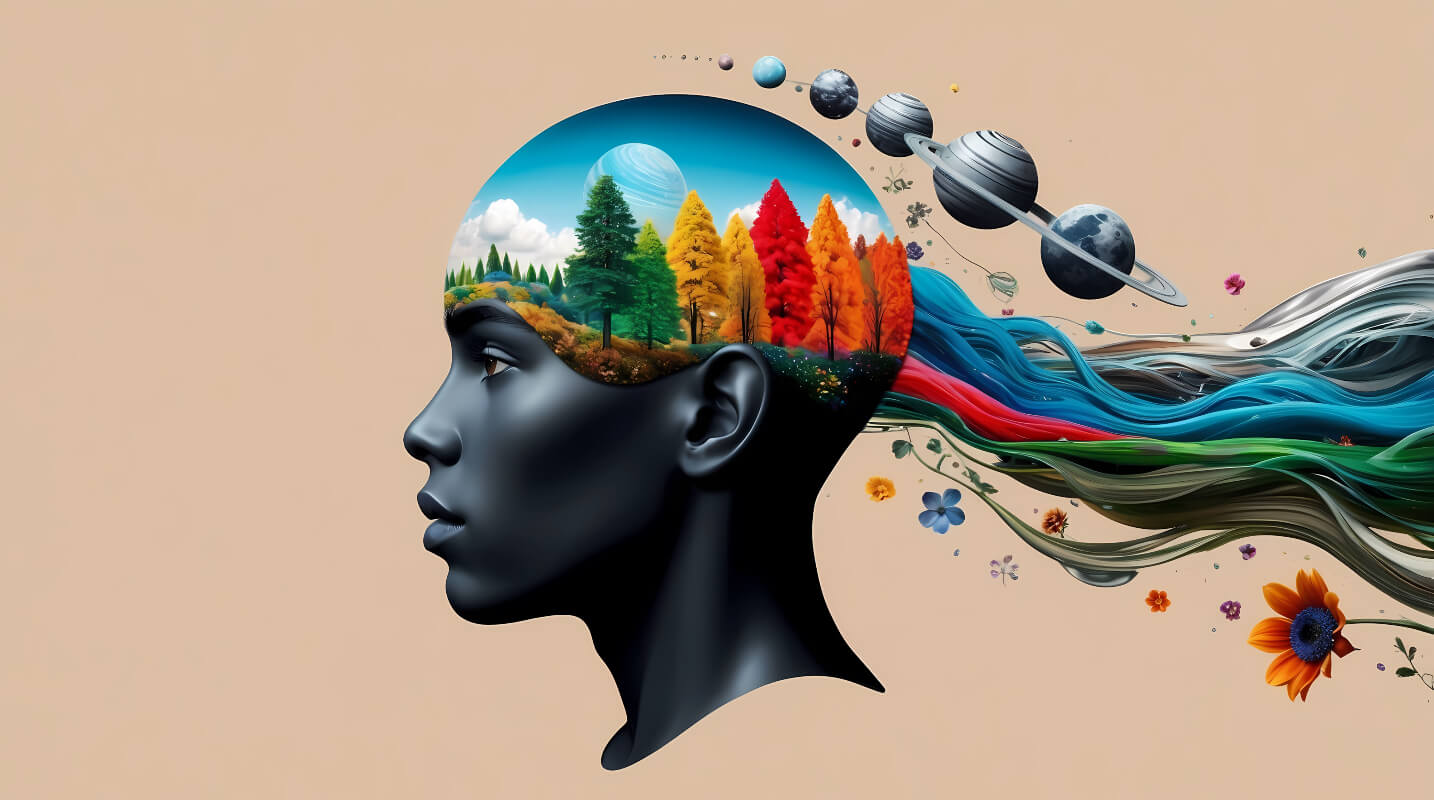Introduction
The relationship between thoughts and reality is not just philosophical mumbo jumbo; it’s about grasping how our mental landscapes can shape our experiences in tangible ways.
Our thoughts hold immense power. They can shape our experiences and manifest our desires in the physical world. This concept isn’t just a whimsical notion; it’s a profound truth that many have tapped into throughout history.
In this article we will delve into:
- The fundamentals of metaphysics and its branches
- How thoughts influence our perception of reality
- Insights into the Law of Attraction and its principles
- Practical steps to harness the power of your thoughts for manifestation
Get ready to explore the metaphysical connections between your mind and the world!
Understanding Metaphysics
Metaphysics is a branch of philosophy that explores the fundamental nature of reality. It looks into concepts like existence, objects, and properties, trying to grasp what it truly means to “be.”
Key Branches of Metaphysics:
- Ontology: This is the study of being and existence. It investigates what entities exist and how they can be categorized. Questions like “What is real?” or “What does it mean for something to exist?” fall under this umbrella.
- Cosmology: This branch looks into the origins and structure of the universe. It explores the relationship between time, space, and everything within them.
- Philosophy of Mind: This area examines the nature of consciousness and how it relates to the physical body.
Fundamental Concepts:
- Existence: At its core, metaphysics contemplates why things are, rather than just what they are.
- Objects: These are entities that have properties and exist in some form. The study includes both concrete objects (like trees and cars) and abstract concepts (such as numbers).
- Properties: Attributes or qualities that objects possess. For instance, color, size, and shape all play a role in defining an object’s identity.
Exploring these branches and concepts reveals how intertwined our thoughts are with our understanding of reality.
The Relationship Between Thoughts and Reality
Understanding how thoughts work within metaphysical frameworks opens up an interesting conversation about the connection between consciousness and reality.

1. Thoughts as Influencers
In many metaphysical traditions, thoughts are not just passing moments in our minds. They have the power to shape our experiences. When we think positively, we often see our surroundings in a more positive light, leading to a more fulfilling life. On the other hand, negative thoughts can cloud our perception and create obstacles to happiness.
The internal dialogue you maintain, known as self talk, plays a crucial role in shaping your reality. It influences your beliefs, attitudes, and actions. Positive self talk can boost your confidence, reduce stress, and enhance your overall emotional state, while negative self talk can do the opposite. Cognitive behavioral therapy emphasizes transforming this internal dialogue to foster a healthier, more positive mindset.
2. Consciousness as a Lens
Our consciousness acts like a filter through which we understand reality. It affects our experiences based on the thoughts we entertain. For instance, someone who focuses on abundance may notice opportunities that a person fixated on scarcity might miss. This interaction between thought and perception shows how closely connected our inner world is with our outer experiences.
3. Perception Shaped by Intent
By recognizing that our thoughts influence reality, we can begin to understand the power of intention. Setting clear intentions helps us use this influence more effectively. When we consciously direct our thoughts towards specific outcomes, we start to align our perceptions with those desired realities.
These ideas encourage us to think about how actively we engage with our thoughts and how they might impact the world around us.
The Law of Attraction: Harnessing the Power of Positive Thinking
Our thoughts generate frequencies that shape our reality, and it’s essential to recognize that these thought patterns influence what we bring into existence.
The Law of Attraction (LoA) is an interesting idea that suggests our thoughts can bring certain experiences into our lives. It’s based on some important principles:
1. Like Attracts Like
This means that similar energies attract one another. Positive thoughts attract positive experiences, while negative thinking tends to draw in negativity.
2. Manifestation Through Focus
By focusing on what you want rather than what you don’t, you send a clear signal to the universe about your desires.

3. Emotional Alignment
Feeling good about your desires enhances their manifestation potential. Joy, gratitude, and love are powerful emotions that can help amplify your intentions.
Think of it this way: when you focus on positive thinking, you’re essentially tuning into a frequency that aligns with abundance and success. In contrast, negative thinking can create a reality filled with challenges and limitations.
Critics of the Law of Attraction often point out that it lacks scientific evidence or dismiss it as “wishful thinking.” Skeptics argue that simply thinking positively won’t change situations without action. Supporters counter that it’s not just about thoughts; it’s about aligning actions with those thoughts for effective manifestation.
Many people find value in LoA practices such as visualization and affirmations, which help maintain a positive mindset. Whether seen as a metaphysical principle or a psychological strategy, the Law of Attraction encourages us to think about how our mental states influence our experiences in life.
How Thoughts Become Reality
To understand how our thoughts can become real things, we need to look at a few ideas that show how our minds connect with the world around us. Here are some important concepts:
1. Sending Signals to the Universe
Every thought can be seen as a signal sent out into the universe. This idea suggests that when we focus our intentions on a specific desire, we are broadcasting our wishes. Visualization techniques often emphasize this aspect, encouraging individuals to picture their goals vividly, creating a strong signal for the universe to respond to.
2. The Role of Mental States
Our mental state plays a significant role in attracting specific outcomes. Positive emotions and an optimistic mindset can enhance our ability to manifest desired experiences. For instance, when feeling joyful or content, individuals are more likely to attract opportunities and situations that resonate with those feelings. Conversely, negative thoughts can lead to undesired outcomes, creating what some refer to as a “vortex of negativity.”
3. Frameworks Explored
Various philosophies and practices delve into this phenomenon. Quantum physics suggests that consciousness influences reality at a fundamental level, while ancient traditions like Buddhism emphasize mindfulness and intention-setting as essential elements in shaping one’s experience.
By understanding these mechanisms, individuals can begin to harness the power of their thoughts, aligning them with their desires to create an intentional reality. It’s about recognizing the active role each person plays in the co-creation of their life experiences.

Interconnectedness of Thought and Existence: A Philosophical Perspective
Exploring the thought-existence relationship reveals a rich tapestry of philosophical views. Philosophers like René Descartes championed the idea that existence stems from thought, famously asserting, “I think, therefore I am.” This perspective underscores how consciousness is foundational to our reality.
Eastern Philosophies: Buddhism and Interconnectedness
Eastern philosophies offer a different lens. For instance, in Buddhism, thoughts are seen as part of an interconnected web of existence. The concept of dependent origination illustrates that nothing exists in isolation; everything is interlinked. This suggests that our thoughts not only shape individual realities but also impact the collective experience.
Western Philosophies: Kant and Objective Reality
Contrastingly, many Western philosophies emphasize the autonomy of thought. Thinkers such as Immanuel Kant argued that while our perceptions shape reality, there exists a world independent of our thoughts. This interplay between subjective experience and objective reality creates a nuanced understanding of how thought influences existence.
Cultural Interpretations and Their Impact
Diving deeper into these cultural interpretations enriches our understanding of interconnectedness. Recognizing diverse perspectives encourages reflection on how thoughts manifest within different frameworks, leading to unique experiences and realities shaped by individual and collective beliefs.
Historical Perspectives on Thought Manifestation: Lessons from the Past
Throughout history, several notable figures have emphasized the incredible power of thought and its ability to shape reality. These individuals recognized that our mental landscapes profoundly influence our actions and outcomes.
1. Mahatma Gandhi
A shining example of thought’s transformative power. Gandhi famously stated, “You must be the change you wish to see in the world.” His philosophy revolved around the idea that positive thoughts lead to constructive actions, ultimately manifesting a better society. He believed that inner peace and strength could translate into societal change, proving that individual mindset can ripple outward.
2. Ralph Waldo Emerson
This American essayist was a strong advocate for individualism and self-reliance. Emerson posited that our thoughts are “things,” capable of influencing both personal lives and the broader environment. His notion of the “Law of Correspondence” suggested that what we focus on internally manifests externally, emphasizing an intimate connection between thought and reality.
3. Napoleon Hill
In his influential work Think and Grow Rich, Hill explored how thoughts can directly correlate with material success. He highlighted the importance of a positive mental attitude in achieving one’s goals, encouraging readers to visualize their desires clearly.
These historical perspectives reinforce the concept that thoughts are not merely fleeting ideas but powerful forces shaping our realities. Embracing this understanding opens pathways to harnessing thought effectively for personal transformation and societal impact.

Modern Interpretations and Practices for Manifestation Success
In today’s fast-paced world, many people are tapping into the power of their minds to manifest their desires. Here are some contemporary methods that have gained traction:
1. Visualization Techniques
Picture this: you want to achieve a specific goal, like landing your dream job or improving your health. Visualization involves creating a mental image of that outcome. It’s like daydreaming with intention! Spend a few minutes each day imagining yourself in that desired situation. Feel the emotions associated with it. This practice not only boosts motivation but also helps align your energy with what you want.
2. Gratitude Practices
Gratitude has become a buzzword for a reason. By focusing on what you’re thankful for, you shift your mindset from scarcity to abundance. Keep a gratitude journal where you jot down things you appreciate daily. This simple act can elevate your vibration, making it easier to attract positive experiences into your life.
3. Conscious Actions
Manifestation isn’t just about thoughts; it’s also about taking steps towards your goals. Think of conscious action as the bridge between desire and reality. This can be as simple as networking for that dream job or adopting healthier habits if you’re aiming for better health. Being proactive reinforces your intentions and shows the universe you’re serious about making changes.
These practices create a powerful synergy, helping you align both mind and actions towards achieving your dreams. As you explore these methods, remember that manifestation is an ongoing journey of growth and self-discovery.
Practical Steps for Effective Manifestation
Manifestation isn’t just about thinking positively; it’s about taking deliberate actions to align your thoughts with your desired outcomes. Here’s a handy step-by-step guide to enhance your manifestation practice:
1. Intention Setting
- Define Clear Goals: Get specific about what you want to manifest. Write down your intentions in a journal.
- Visualize Your Success: Spend time imagining yourself living out your desires. Feel the emotions associated with achieving these goals.
- Create a Vision Board: Collect images, quotes, and symbols that represent your intentions. Place it somewhere visible to keep your focus sharp.
2. Utilizing Affirmations
- Craft Positive Statements: Formulate affirmations that resonate with you. For example, “I am worthy of my dreams” or “Abundance flows to me effortlessly.”
- Daily Repetition: Repeat these affirmations daily, preferably in front of a mirror to reinforce their power.
- Feel the Words: As you speak these affirmations, embody the feelings they evoke. This emotional connection amplifies their effectiveness.
3. Mindfulness Practices
- Stay Present: Engage in mindfulness meditation to cultivate awareness and presence. This helps clear mental clutter and enhances focus on your intentions.
- Observe Your Thoughts: Notice any negative thoughts that arise without judgment. Acknowledge them and gently redirect your focus back to positive outcomes.
- Gratitude Journaling: Regularly write down things you’re grateful for, reinforcing a positive mindset and attracting more good into your life.
Incorporating these practical steps into your daily routine can significantly enhance your manifestation journey and bring you closer to the realities you desire.

Challenges, Misconceptions, and Skepticism Towards Manifestation Practices
Manifestation is a fascinating concept, but it’s often clouded by misconceptions and skepticism. Here are some common misunderstandings surrounding the idea that thoughts can create realities:
Common Misunderstandings
- Wishful Thinking: Many believe that simply wishing for something is enough to bring it into existence. The reality is more nuanced; it requires consistent effort, belief, and action.
- Instant Results: Some expect immediate gratification from their thoughts. True manifestation involves patience and persistence, as changes may take time to materialize.
Challenges arise when individuals attempt to apply these principles in their daily lives:
Challenges in Applying Manifestation
- Doubts and Negative Beliefs: Inner skepticism can be a major roadblock. Many people struggle with self-doubt, undermining their ability to manifest their desires effectively.
- Lack of Clarity: Setting vague intentions can lead to confusion about what one truly wants. Clear and specific goals are essential for effective manifestation.
Addressing these challenges and misconceptions is key to unlocking the power of manifestation in one’s life. Understanding the deeper mechanisms behind thoughts and beliefs allows for a more grounded approach to creating desired realities.
Embracing Your Role as a Co-Creator: Final Thoughts
It’s time to reflect on your beliefs about how thoughts shape realities. Engage with these ideas:
- Explore Your Mindset: Consider how your thoughts influence your daily experiences. What patterns do you notice?
- Challenge Negative Beliefs: Recognize any limiting beliefs that might hold you back from manifesting your desires.
Take action! Start applying the principles discussed throughout this article:
- Set Intention: Clearly define what you want to manifest in your life.
- Practice Mindfulness: Stay present and aware of your thoughts and emotions as they create your reality.
Remember, the metaphysics of how thoughts create realities is not just theory; it’s an invitation to co-create your life. Embrace this journey, and watch as your reality transforms in alignment with your intentions.

Hi, I’m Holly Celestine and I am a Licensed Vibrational Sound Therapy Practitioner on a mission to liberate and activate your highest human potential. In pursuit of avenues that bring the entire body into balance and harmony, I found that sound, vibration and frequency play a vital role in the symbiotic connection to our mental, emotional, and physical well-being. In addition to being a Licensed Vibrational Sound Therapy Practitioner, I’m certified in Biofield Tuning, Voice Analysis, Massage Therapy, Usui Reiki Master, and Bodytalk.
I use vibrational sound therapy for targeted nervous system relaxation to help people feel relief from their debilitating stress, anxiety, and chronic pain. I’m a life-long learner, ever evolving and consciously expanding into my best self, tuning into wholeness and balanced vibrations! Connect with me to amplify your highest expression using Sound Therapy.
In my Universal Harmony studio, you can experience how the sound combination of the gong, singing bowl and chimes create harmonic resonance that enhances and revitalizes your energy. By focusing on each of the seven chakras, the experience helps you connect more deeply with yourself and to Source energy. I often play uplifting tunes as participants surround themselves in beautiful instruments. Whether you’re looking for a partner, a group or to enjoy life fully as a single, these sessions provides enhanced awareness that impacts body, mind and spirit.
For a personalized session, you can schedule your appointment with me here.




